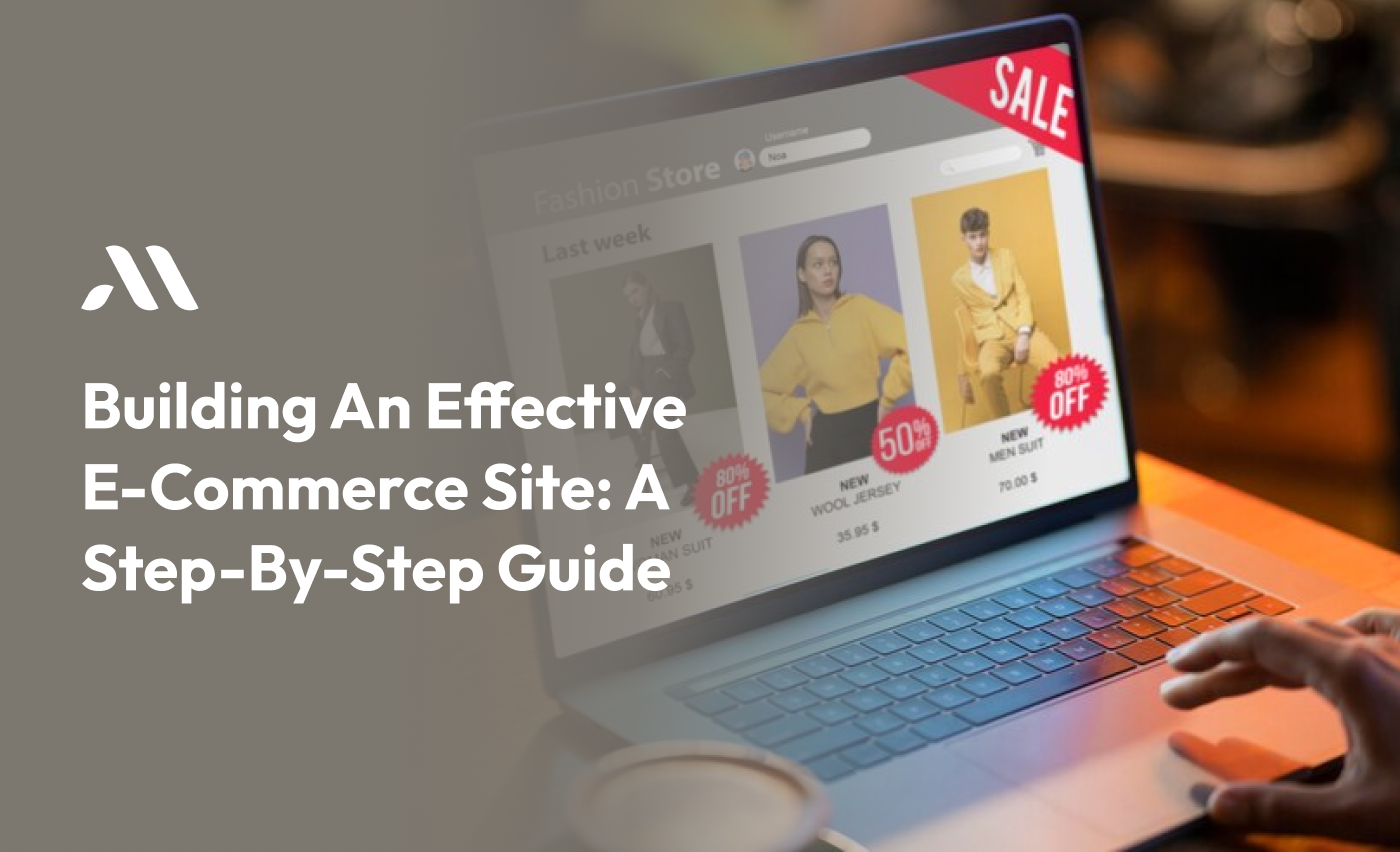The internet has changed the way we shop, and e-commerce websites have become the go-to place for many businesses to sell products. For e-commerce-related business owners, building an effective e-commerce site is one of the best ways to attract customers and grow sales. In this guide, we'll walk you through the steps to build an effective e-commerce site that brings visitors and encourages them to make a purchase.
Building a site that works is easy if you follow these steps carefully, whether you're doing it yourself or hiring a website development company to help. Let’s get started!
Step 1: Plan Your E-commerce Site’s Purpose and Audience
The first step in building an effective e-commerce site is to know who you're building it for.
Define your goals – Do you want to attract more customers, build brand loyalty, or increase your sales?
Know your target audience – Are they kids, adults, or teenagers? Are they looking for deals, or are they more interested in quality? Knowing this helps shape your website to meet their needs.
Example: If you’re selling kids' toys, your website should be bright, fun, and easy to navigate.
“Knowing who you’re building for helps you make decisions that attract the right customers to your e-commerce site.”
Step 2: Choose a Reliable Website Development Company or Platform
If you're new to website creation, working with a professional website development company can make things easier. They’ll handle the technical parts so you can focus on other aspects of your business. However, if you’re confident and want to build your site yourself, platforms like Shopify, WooCommerce, and BigCommerce are great choices.
Step 3: Pick the Right E-commerce Site Design
An effective e-commerce site has a design that is simple, appealing, and professional.
Tips for Good E-commerce Site Design:
- Choose clear fonts – Make sure the text is easy to read.
- Stick to two or three colors – Use your brand colors consistently.
- Use high-quality images – Photos of your products should be clear and attractive.
- Make the site mobile-friendly – Over 60% of online shopping happens on phones, so your site needs to work well on small screens.
“Your e-commerce site’s design is like your store’s window display – make it inviting to attract more customers!”
Step 4: Focus on User-Friendly Navigation
Navigation is how visitors find what they’re looking for on your e-commerce site. If they can’t find products easily, they’re likely to leave.
Tips for User-Friendly Navigation:
- Organize products into categories – Use clear, specific labels like "Men's Shoes" or "Home Decor."
- Use a search bar – Let customers type in what they’re looking for directly.
- Highlight important pages – Links to "Sale," "New Arrivals," and "Best Sellers" should be easy to find.
Step 5: Choose a Secure and Fast Payment System
A secure payment system builds trust with your customers and helps prevent fraud. Your e-commerce site should allow users to pay with popular options like credit cards, PayPal, and other online wallets.
Did you know? Online stores lose up to 18% of customers due to slow checkout processes.
Remember: Customers want a safe, quick, and simple way to buy products from your site.
Step 6: Optimize Your E-commerce Site for SEO
To build an effective e-commerce site, you need customers to find you! That’s where Search Engine Optimization (SEO) comes in. SEO is about helping search engines like Google understand and recommend your site.
SEO Tips:
- Use the right keywords – Include words people might use to find your products, like “organic face cream” or “affordable kids’ toys.”
- Add meta descriptions – These short descriptions appear in Google search results and help attract visitors.
- Make URLs easy to read – Instead of random letters and numbers, use product names in your URLs (e.g., www.mystore.com/blue-sneakers).
- Use high-quality images and alt text – Alt text helps search engines understand your images, so include keywords where possible.
“The easier it is for search engines to find your e-commerce site, the more people will visit it.”
Step 7: Add Product Descriptions and Reviews
Effective e-commerce sites tell customers about products in ways that help them decide to buy.
Tips for Product Descriptions:
- Use simple words – Customers want information that’s easy to understand.
- Focus on benefits, not just features – Instead of just saying “lightweight,” explain how this makes the product easy to carry.
- Include reviews – Over 70% of online buyers look at product reviews before purchasing. Reviews build trust and help customers feel more confident about buying.
Also Read - Responsive Design for Websites: Why It Matters
Step 8: Set Up an Easy-to-Use Checkout Process
A smooth checkout process can make or break your e-commerce site. If it’s too complicated, customers will leave their shopping carts without buying.
Checkout Process Tips:
- Allow guest checkout – Not everyone wants to create an account.
- Show the total price early – Include taxes and shipping to avoid surprises.
- Provide multiple payment methods – Credit cards, PayPal, and local payment options should all be available.
Note: Studies show that 68% of customers abandon their shopping carts due to complicated checkouts.
Step 9: Use Strong Security Features
Security is crucial for an effective e-commerce site. Customers need to trust that their information is safe when shopping on your site. Adding security features like an SSL certificate and two-factor authentication helps protect your customers’ data.
Security Tips:
- Use HTTPS – This shows that your site is secure.
- Install firewalls and antivirus – These help protect against hacking.
- Keep your platform updated – Regular updates improve security.
Step 10: Test and Launch Your E-commerce Site
Before your e-commerce site goes live, test everything! Make sure all links, buttons, and forms work.
Testing Checklist:
- Test on different devices – Your site should work on desktops, tablets, and phones.
- Check for fast loading times – A slow site can frustrate visitors and cause them to leave.
- Ensure security and payment features work – Test your payment systems to avoid issues.
Remember: An effective e-commerce site should be fast, user-friendly, and secure.
Step 11: Market Your E-commerce Site
Once your e-commerce site is live, you need to spread the word! Marketing helps bring visitors to your site and can include social media marketing, email campaigns, and paid ads.
Tip: Providing discounts or promotions in your marketing can encourage new customers to try your site!
Example Marketing Strategies:
- Social Media – Show off your products on Instagram, Facebook, and Twitter.
- Email Newsletters – Send updates about new products, sales, and special offers.
- Paid Ads – Use Google Ads or social media ads to reach more people.
Final Thoughts
Building an effective e-commerce site doesn’t happen overnight, but each step brings you closer to creating a successful online store. Remember, a well-designed site, easy-to-use navigation, and secure payments are key elements in the website development process. By following these steps, you’re setting your business up for success and making it easier for customers to find, trust, and buy from you.
Looking to build an effective e-commerce site? MicraSol can help! Our expert team makes creating a user-friendly, secure, and successful online store easy. From design to checkout, we handle it all so you can focus on growing your business. Start your journey with MicraSol today reach out now!
FAQS
Can I build an e-commerce site myself, or do I need to hire a website development company?
You can build it yourself if you’re comfortable using website builders like Shopify, WooCommerce, or BigCommerce. However, if you want a more professional site with custom features, a website development company can help. They handle the technical parts, so you can focus on your products.
What makes an e-commerce site “effective”?
An effective e-commerce site is easy to use, fast, and safe. It should have clear product descriptions, easy navigation, and a secure checkout process. A good e-commerce site keeps customers happy and encourages them to buy from you.
Why is it important to have a simple checkout process?
A simple checkout process makes it easy for customers to complete their purchases. If checkout is too confusing or long, people may leave without buying. A guest checkout option, showing the full price (including shipping), and multiple payment options all help make checkout easier.
How can SEO help my e-commerce site?
SEO, or Search Engine Optimization, helps your e-commerce site show up in search results on Google and other search engines. By using the right keywords, adding product descriptions, and having good-quality images, more people can find your site and visit it.
What is SSL, and why is it important for my e-commerce site?
SSL (Secure Sockets Layer) is a security feature that protects your site and your customers' information. It’s important because it keeps customers' data, like credit card information, safe from hackers. Sites with SSL have “https” in the URL and show a padlock icon, which builds trust with customers.








